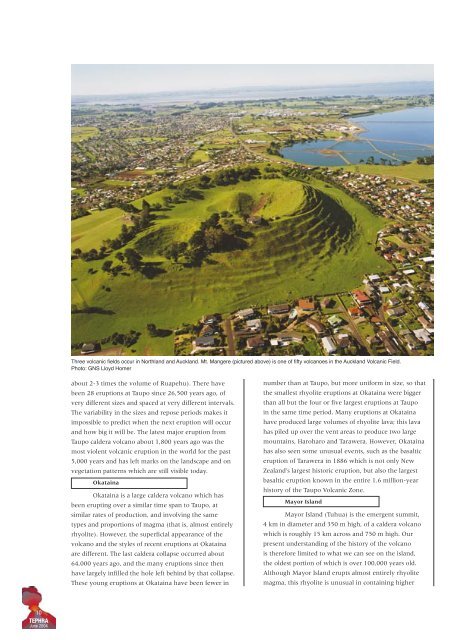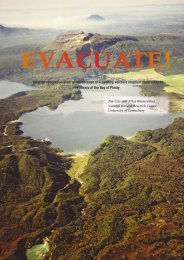Volcanoes - Ministry of Civil Defence and Emergency Management
Volcanoes - Ministry of Civil Defence and Emergency Management
Volcanoes - Ministry of Civil Defence and Emergency Management
Create successful ePaper yourself
Turn your PDF publications into a flip-book with our unique Google optimized e-Paper software.
HI-RES PIC TO BE SOURCED<br />
Three volcanic fields occur in Northl<strong>and</strong> <strong>and</strong> Auckl<strong>and</strong>. Mt. Mangere (pictured above) is one <strong>of</strong> fifty volcanoes in the Auckl<strong>and</strong> Volcanic Field.<br />
Photo: GNS Lloyd Homer<br />
about 2-3 times the volume <strong>of</strong> Ruapehu). There have<br />
been 28 eruptions at Taupo since 26,500 years ago, <strong>of</strong><br />
very different sizes <strong>and</strong> spaced at very different intervals.<br />
The variability in the sizes <strong>and</strong> repose periods makes it<br />
impossible to predict when the next eruption will occur<br />
<strong>and</strong> how big it will be. The latest major eruption from<br />
Taupo caldera volcano about 1,800 years ago was the<br />
most violent volcanic eruption in the world for the past<br />
5,000 years <strong>and</strong> has left marks on the l<strong>and</strong>scape <strong>and</strong> on<br />
vegetation patterns which are still visible today.<br />
Okataina<br />
Okataina is a large caldera volcano which has<br />
been erupting over a similar time span to Taupo, at<br />
similar rates <strong>of</strong> production, <strong>and</strong> involving the same<br />
types <strong>and</strong> proportions <strong>of</strong> magma (that is, almost entirely<br />
rhyolite). However, the superficial appearance <strong>of</strong> the<br />
volcano <strong>and</strong> the styles <strong>of</strong> recent eruptions at Okataina<br />
are different. The last caldera collapse occurred about<br />
64,000 years ago, <strong>and</strong> the many eruptions since then<br />
have largely infilled the hole left behind by that collapse.<br />
These young eruptions at Okataina have been fewer in<br />
number than at Taupo, but more uniform in size, so that<br />
the smallest rhyolite eruptions at Okataina were bigger<br />
than all but the four or five largest eruptions at Taupo<br />
in the same time period. Many eruptions at Okataina<br />
have produced large volumes <strong>of</strong> rhyolite lava; this lava<br />
has piled up over the vent areas to produce two large<br />
mountains, Haroharo <strong>and</strong> Tarawera. However, Okataina<br />
has also seen some unusual events, such as the basaltic<br />
eruption <strong>of</strong> Tarawera in 1886 which is not only New<br />
Zeal<strong>and</strong>’s largest historic eruption, but also the largest<br />
basaltic eruption known in the entire 1.6 million-year<br />
history <strong>of</strong> the Taupo Volcanic Zone.<br />
Mayor Isl<strong>and</strong><br />
Mayor Isl<strong>and</strong> (Tuhua) is the emergent summit,<br />
4 km in diameter <strong>and</strong> 350 m high, <strong>of</strong> a caldera volcano<br />
which is roughly 15 km across <strong>and</strong> 750 m high. Our<br />
present underst<strong>and</strong>ing <strong>of</strong> the history <strong>of</strong> the volcano<br />
is therefore limited to what we can see on the isl<strong>and</strong>,<br />
the oldest portion <strong>of</strong> which is over 100,000 years old.<br />
Although Mayor Isl<strong>and</strong> erupts almost entirely rhyolite<br />
magma, this rhyolite is unusual in containing higher<br />
10<br />
TEPHRA<br />
June 2004

















